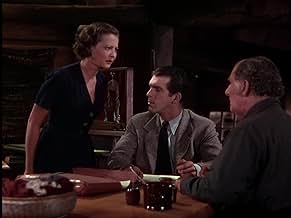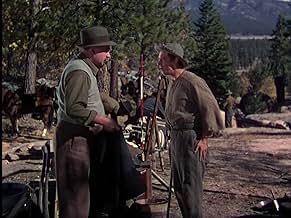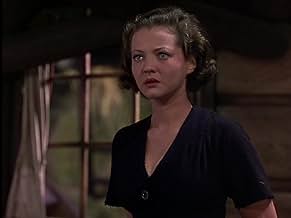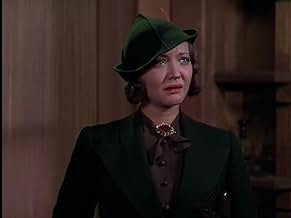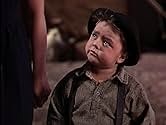IMDb-BEWERTUNG
6,8/10
1451
IHRE BEWERTUNG
Füge eine Handlung in deiner Sprache hinzuA railroad man from the city befriends a mountain girl in a Kentucky family feud.A railroad man from the city befriends a mountain girl in a Kentucky family feud.A railroad man from the city befriends a mountain girl in a Kentucky family feud.
- Für 1 Oscar nominiert
- 5 Gewinne & 2 Nominierungen insgesamt
George 'Spanky' McFarland
- Buddie Tolliver
- (as Spanky McFarland)
Samuel S. Hinds
- Sheriff
- (as Samuel Hinds)
Henry Brandon
- Wade Falin
- (as Henry Kleinbach)
Jess Barker
- Merd Falin
- (as Philip Barker)
Empfohlene Bewertungen
`In the Blue Ridge Mountains of Virginia, on THE TRAIL OF THE LONESOME PINE,' a young woman discovers love, but no respite from the violent feud which has torn apart two families.
Full of good performances & boasting excellent production values courtesy of Paramount Studios, this fine drama brings to its viewers a not-so-subtle message of peace & tolerance. The vividly depicted consequences of mindless, violent behavior give the film a real punch.
The film's romantic triangle consists of barefoot mountain lass Sylvia Sidney, her decent, uncomplicated cousin Henry Fonda, and mining executive Fred MacMurray, who, as a newcomer to the backwoods, rebels against the traditions of violence & revenge he finds there. All three deliver compelling performances, with a slight advantage going to the gentlemen, as their roles do not require as much shrill, fickle behavior as does Miss Sidney's.
The marvelous character actress Beulah Bondi appears as Miss Sidney's mother, one of the first in a decades-long line of stubborn, proud old women she would play; her eyes tell of the world of trouble her character has seen on the mountain. Cuddly Nigel Bruce is MacMurray's associate - gruff & grumbly, but with a heart of gold.
Special mention should be made of seven-year-old Spanky McFarland, who plays Miss Sidney's little brother. Already the star of numerous OUR GANG comedies, the tiny tyke here displays the talent that placed him in the front rank of child movie stars. Precocious & poignant, Spanky's character is quite unforgettable.
Fred Stone & Robert Barrat play the heads of the two feuding clans, one gentle - the other fierce. Movie mavens will recognize Clara Blandick as a frightened landlady and Samuel S. Hinds as the Gaptown sheriff.
The film is stitched together by the evocative, nostalgic singing of Fuzzy Knight, who introduces Twilight On The Trail' & A Melody From The Sky,' (both by Louis Alter and Sidney D. Mitchell). The tune for the chorus of The Trail Of The Lonesome Pine,' by Ballard MacDonald & Harry Carroll, can be briefly heard during the opening credits; viewers will need to watch Laurel & Hardy's WAY OUT WEST (1937) to hear this fine old song actually sung.
Famous as the first outdoor film produced in full Technicolor, THE TRAIL OF THE LONESOME PINE benefits greatly from its location filming near Cedar Lake, in California's San Bernardino Mountains.
Full of good performances & boasting excellent production values courtesy of Paramount Studios, this fine drama brings to its viewers a not-so-subtle message of peace & tolerance. The vividly depicted consequences of mindless, violent behavior give the film a real punch.
The film's romantic triangle consists of barefoot mountain lass Sylvia Sidney, her decent, uncomplicated cousin Henry Fonda, and mining executive Fred MacMurray, who, as a newcomer to the backwoods, rebels against the traditions of violence & revenge he finds there. All three deliver compelling performances, with a slight advantage going to the gentlemen, as their roles do not require as much shrill, fickle behavior as does Miss Sidney's.
The marvelous character actress Beulah Bondi appears as Miss Sidney's mother, one of the first in a decades-long line of stubborn, proud old women she would play; her eyes tell of the world of trouble her character has seen on the mountain. Cuddly Nigel Bruce is MacMurray's associate - gruff & grumbly, but with a heart of gold.
Special mention should be made of seven-year-old Spanky McFarland, who plays Miss Sidney's little brother. Already the star of numerous OUR GANG comedies, the tiny tyke here displays the talent that placed him in the front rank of child movie stars. Precocious & poignant, Spanky's character is quite unforgettable.
Fred Stone & Robert Barrat play the heads of the two feuding clans, one gentle - the other fierce. Movie mavens will recognize Clara Blandick as a frightened landlady and Samuel S. Hinds as the Gaptown sheriff.
The film is stitched together by the evocative, nostalgic singing of Fuzzy Knight, who introduces Twilight On The Trail' & A Melody From The Sky,' (both by Louis Alter and Sidney D. Mitchell). The tune for the chorus of The Trail Of The Lonesome Pine,' by Ballard MacDonald & Harry Carroll, can be briefly heard during the opening credits; viewers will need to watch Laurel & Hardy's WAY OUT WEST (1937) to hear this fine old song actually sung.
Famous as the first outdoor film produced in full Technicolor, THE TRAIL OF THE LONESOME PINE benefits greatly from its location filming near Cedar Lake, in California's San Bernardino Mountains.
I saw this movie when I was 15 years old and never forgot it; I now have a copy of it and watch it often and enjoy it as much as when it first came out in 1936.
This sound version of The Trail of the Lonesome Pine is actually the fourth and to date last version of this story. There were three silent films made from this novel by John Fox, Jr., including one done in 1916 by Cecil B. DeMille.
It's the story of a couple of Appalachian Mountain families who've had a decades old feud in which no one can quite recall how it all got started, but they sure do remember the latest outrage by the other crowd. There's a great temptation to treat this all humorously and it certainly has been done, I can recall Abbott and Costello's Comin' Round the Mountain with the same plot premise. But whole people's and whole nations act this way, who are we to judge the Tollivers and Falins of this story.
Sylvia Sidney and Henry Fonda are two Tolliver cousins, kissing cousins as they say in the mountains, distant enough to contemplate marriage. Into the picture comes railroad man Fred MacMurray who wants to build a railroad through the properties of both families. He interests Sylvia who starts to see that there is a whole world away from her family and their feud.
Of course when her little brother is killed the whole ugly business starts up again and it leaves tragedy again in both families.
The Trail of the Lonesome Pine has its place in film history as the first outdoor as opposed to studio film shot in three strip technicolor. Color which is now standard was a big gimmick back in the day and Paramount raked in good box office.
Fuzzy Knight plays another rustic character, kind of a Tolliver satellite and he sings a couple of songs written for the film by Louis Alter and Sidney Mitchell, Twilight on the Trail and A Melody from the Sky. The latter got an Academy Award nomination for Best Song, losing to The Way You Look Tonight. The former however got a recording by Bing Crosby. This is a perfect example of the connection of film, and radio, and the recording industry. Bing was Paramount's number one box office attraction and the Paramount executives no doubt prevailed on him to record the song and sing it on his brand new Kraft Music Hall Radio Show in the interest of publicizing The Trail of the Lonesome Pine.
Fred MacMurray and Sylvia Sidney were also with Paramount at the time and Henry Fonda was at that time under contract to producer Walter Wanger who filmed this story. Those were the days way before agents and stars being their own producers. Such cozy arrangements as these were more easily done then.
This last to date version of The Trail of the Lonesome Pine probably is too old fashioned for a remake. Still I think today's audiences might still enjoy it.
It's the story of a couple of Appalachian Mountain families who've had a decades old feud in which no one can quite recall how it all got started, but they sure do remember the latest outrage by the other crowd. There's a great temptation to treat this all humorously and it certainly has been done, I can recall Abbott and Costello's Comin' Round the Mountain with the same plot premise. But whole people's and whole nations act this way, who are we to judge the Tollivers and Falins of this story.
Sylvia Sidney and Henry Fonda are two Tolliver cousins, kissing cousins as they say in the mountains, distant enough to contemplate marriage. Into the picture comes railroad man Fred MacMurray who wants to build a railroad through the properties of both families. He interests Sylvia who starts to see that there is a whole world away from her family and their feud.
Of course when her little brother is killed the whole ugly business starts up again and it leaves tragedy again in both families.
The Trail of the Lonesome Pine has its place in film history as the first outdoor as opposed to studio film shot in three strip technicolor. Color which is now standard was a big gimmick back in the day and Paramount raked in good box office.
Fuzzy Knight plays another rustic character, kind of a Tolliver satellite and he sings a couple of songs written for the film by Louis Alter and Sidney Mitchell, Twilight on the Trail and A Melody from the Sky. The latter got an Academy Award nomination for Best Song, losing to The Way You Look Tonight. The former however got a recording by Bing Crosby. This is a perfect example of the connection of film, and radio, and the recording industry. Bing was Paramount's number one box office attraction and the Paramount executives no doubt prevailed on him to record the song and sing it on his brand new Kraft Music Hall Radio Show in the interest of publicizing The Trail of the Lonesome Pine.
Fred MacMurray and Sylvia Sidney were also with Paramount at the time and Henry Fonda was at that time under contract to producer Walter Wanger who filmed this story. Those were the days way before agents and stars being their own producers. Such cozy arrangements as these were more easily done then.
This last to date version of The Trail of the Lonesome Pine probably is too old fashioned for a remake. Still I think today's audiences might still enjoy it.
THE TRAIL OF THE LONESOME PINE (1936) is a landmark color film of considerable dramatic power that has been neglected in Hollywood history. It was the second full-length feature to be produced in the newly-developed 3 strip Technicolor process. The first Technicolor feature, BECKY SHARP, had opened the previous year (1935) but did not find audience favor. There is strong evidence to suggest that THE TRAIL OF THE LONESOME PINE was the film that really popularized color.
Aside from the superb color photography, the film has much to recommend it. There are very strong performances, particularly that of Sylvia Sidney as the backwoods mountain girl - a very convincing portrayal. She is supported by two handsome newcomers, Henry Fonda and Fred MacMurray, plus veterans such as Fred Stone, Beulah Bondi, and Spanky MacFarland. The story line is very compelling and there is the strong direction of Henry Hathaway (LIVES OF A BENGAL LANCER, KISS OF DEATH, TRUE GRIT). In its original release, audiences reportedly burst into applause while viewing some of the color scenes. The film was a box office smash for Paramount, playing to packed houses in both large and small towns. (This is well documented.) It remains compelling entertainment today. The high-quality color photography was very much in evidence in the VHS tape that MCA released in the Nineties. It is to be hoped that the same high quality will be seen in the projected 2009 DVD release of this beloved film.
Aside from the superb color photography, the film has much to recommend it. There are very strong performances, particularly that of Sylvia Sidney as the backwoods mountain girl - a very convincing portrayal. She is supported by two handsome newcomers, Henry Fonda and Fred MacMurray, plus veterans such as Fred Stone, Beulah Bondi, and Spanky MacFarland. The story line is very compelling and there is the strong direction of Henry Hathaway (LIVES OF A BENGAL LANCER, KISS OF DEATH, TRUE GRIT). In its original release, audiences reportedly burst into applause while viewing some of the color scenes. The film was a box office smash for Paramount, playing to packed houses in both large and small towns. (This is well documented.) It remains compelling entertainment today. The high-quality color photography was very much in evidence in the VHS tape that MCA released in the Nineties. It is to be hoped that the same high quality will be seen in the projected 2009 DVD release of this beloved film.
The movie's an affecting tale of feuding backwoods families, who must also make adjustments to encroaching modern world. I was expecting a Romeo-Juliet situation with the families, but that's surprisingly not the case. Instead June (Sidney) has to decide between her cousin Dave (Fonda) and outsider Hale (MacMurray). Tradition favors Dave, but her heart favors Hale. At the same time, railroad developers are crossing land owned by each family, and neither the Tollivers nor the Falins wants to accommodate their hereditary enemy. They'd rather shoot each other if they get the chance. And who knows how the enmity started, except now it's part of both families' tradition. If the movie's flawed, it's with the use of of popular backwoods stereotypes.
Apparently this was the first outdoor Technicolor feature (IMDB), but you'd never know it. Visually the film is quite striking, with a lot of beautiful outdoor compositions. Also, you'd never guess these were filmed just 35-miles east of LA in the San Bernardino mountains. The acting too is first-rate—a soulful Sydney, an ornery Fonda, and an underrated MacMurray. Then there's Sherlock Holmes' favorite Dr. Watson, Nigel Bruce, in a non-comedic role. Needless to say, that took some adjustment for this old Sherlock fan. In fact, there're a couple other unexpected cast members, as well: Little Rascal Spanky McFarland and comedic Fuzzy Knight. And, of course, mustn't forget everyone's favorite hard-scrabble mom, Beulah Bondi, as the long-suffering ma Tolliver.
I like the way the movie works the culture clash between tradition and modernity into the plot. The railroad company pays big money for land use, and that along with a railway to service the expected coal deposits, is bringing the backwoods into the modern age, as June's evolution shows. Of course, not everyone's supportive of change, particularly dad Tolliver (Stone). The movie has some uncommonly poignant moments, especially that final sequence, which conveys an extraordinary emotional power. As a kid, I recall bawling at it, and even now as a geezer, it brought a tear to the eye. As I see it, Fuzzy and his dog are mourning not only friends but the passing of a simpler way of life.
All in all, the movie is surprisingly good, with a strong story, commanding visuals, and a thoughtful subtext. So don't pass it up because of a relative obscurity.
Apparently this was the first outdoor Technicolor feature (IMDB), but you'd never know it. Visually the film is quite striking, with a lot of beautiful outdoor compositions. Also, you'd never guess these were filmed just 35-miles east of LA in the San Bernardino mountains. The acting too is first-rate—a soulful Sydney, an ornery Fonda, and an underrated MacMurray. Then there's Sherlock Holmes' favorite Dr. Watson, Nigel Bruce, in a non-comedic role. Needless to say, that took some adjustment for this old Sherlock fan. In fact, there're a couple other unexpected cast members, as well: Little Rascal Spanky McFarland and comedic Fuzzy Knight. And, of course, mustn't forget everyone's favorite hard-scrabble mom, Beulah Bondi, as the long-suffering ma Tolliver.
I like the way the movie works the culture clash between tradition and modernity into the plot. The railroad company pays big money for land use, and that along with a railway to service the expected coal deposits, is bringing the backwoods into the modern age, as June's evolution shows. Of course, not everyone's supportive of change, particularly dad Tolliver (Stone). The movie has some uncommonly poignant moments, especially that final sequence, which conveys an extraordinary emotional power. As a kid, I recall bawling at it, and even now as a geezer, it brought a tear to the eye. As I see it, Fuzzy and his dog are mourning not only friends but the passing of a simpler way of life.
All in all, the movie is surprisingly good, with a strong story, commanding visuals, and a thoughtful subtext. So don't pass it up because of a relative obscurity.
Wusstest du schon
- WissenswertesParamount's first Technicolor feature and the first feature to be shot in Three-Strip Technicolor outside of a studio environment (on location).
- PatzerThe mud on June Tolliver changes thickness and shape between shots. It also changes from wet to dry and then back to wet.
- Zitate
Melissa Tolliver: I was born old...
- Crazy CreditsThe opening credits (except for the Paramount logo) all appear as if they had been printed on tree barks.
- VerbindungenEdited into The Our Gang Story (1994)
Top-Auswahl
Melde dich zum Bewerten an und greife auf die Watchlist für personalisierte Empfehlungen zu.
- How long is The Trail of the Lonesome Pine?Powered by Alexa
Details
- Erscheinungsdatum
- Herkunftsland
- Sprache
- Auch bekannt als
- The Trail of the Lonesome Pine
- Drehorte
- Produktionsfirmen
- Weitere beteiligte Unternehmen bei IMDbPro anzeigen
- Laufzeit1 Stunde 42 Minuten
- Seitenverhältnis
- 1.37 : 1
Zu dieser Seite beitragen
Bearbeitung vorschlagen oder fehlenden Inhalt hinzufügen

Oberste Lücke
By what name was Kampf in den Bergen (1936) officially released in India in English?
Antwort
